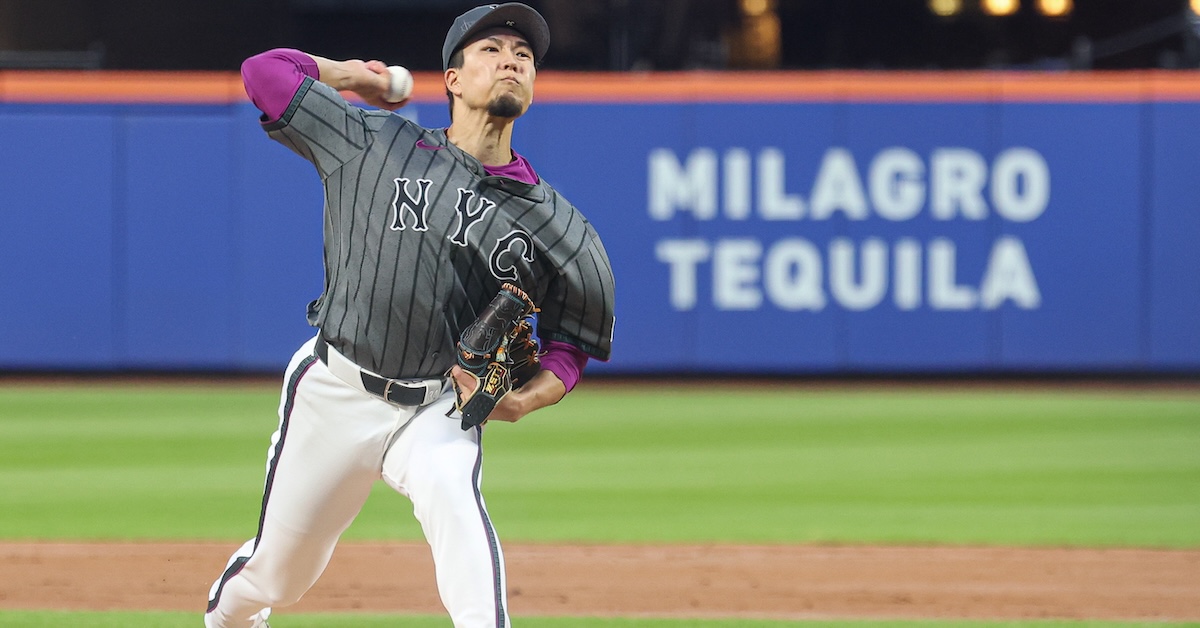
A few weeks in the past, Hannah Keyser of The Bandwagon requested Kodai Senga about his reverse splits relating to instances by way of the order. His .347 wOBA allowed the primary time by way of the lineup drops to .275 the second time by way of it, after which sinks to .205 the third time by way of. Nevertheless, his complete batters confronted sits at simply 90 for every of the primary two instances by way of the order and 48 for the third time by way of. That’s a sufficiently small pattern that it’s tough to say how a lot of the credit score goes to Senga and the way a lot is of course occurring variation.
Both manner it doesn’t matter a lot to Senga, who cares extra about course of than outcomes, “Fairly actually, I don’t really feel like I’m excellent at any level through the sport this 12 months,” he instructed Keyser by way of his interpreter. Harsh phrases for a pitcher with an ERA- of 37. He does acknowledge that he makes changes all through the sport to get a greater really feel for his pitches and tweaks his technique based mostly on how every pitch is trying in a given begin, which gives some clarification for the improved outcomes as the sport goes on. However in keeping with Senga, all of his pitches really feel off this 12 months, as he stays within the strategy of re-establishing his mechanics following the shoulder and calf accidents that sidelined him for practically all of final 12 months.
Senga’s self-evaluation reminds us that people performing on the elite degree of their fields don’t get there by letting ok be ok, however somewhat by insisting that nothing is ever ok. To the layperson, it’s baffling to listen to that Senga feels he’s pitching worse, regardless of posting higher outcomes than in 2023, his first MLB season, and the final wherein he was totally wholesome. Add on that he by some means manages to achieve effectiveness all through his begins regardless of a sure degree of displeasure with all of his pitches, and it couldn’t be any clearer that no matter what you learn in Us Weekly, the celebrities usually are not really identical to us.
However in refusing to depart himself a five-star evaluation, Senga units up not less than two mind teasers for us laypeople to puzzle by way of. In describing the necessity to get again to his pre-injury mechanics, or not less than that degree of confidence in his mechanics, he instructed Keyser, “[I]f you dig somewhat bit deeper, on the analytics of my pitches and the pitching itself, there’s rather a lot that I can enhance on. And I anticipate myself to be rather a lot higher.” What detectable variations are there between Senga in 2023 and Senga this season that may make him really feel he nonetheless has room for enchancment, though hitters have been much less profitable in opposition to him this 12 months? After which the second thriller is figuring out the in-game diversifications that enable Senga to level-up his outcomes as an outing progresses, however extra on that later.
Since Senga clearly feels there’s one thing off along with his mechanics, let’s begin there. His arm angle is a couple of levels decrease, dropping from 48 levels to 45. Maybe this developed in response to the shoulder damage, both as compensation or to protect in opposition to future damage in some small manner. It’s not a big distinction, but it surely might affect Senga’s wrist place when releasing the ball. A number of of Senga’s choices derive a few of their motion from seam-shifted wake, which occurs when the ball’s seams are oriented in such a manner that creates a “wake” of further drive because the ball strikes by way of the air, impacting its trajectory. When a pitch is influenced by seam-shifted wake, its noticed spin axis differs from what we’d usually anticipate from a pitch with the identical velocity and motion. Of Senga’s choices, the most important benefactors of seam-shifted wake are his forkball (or ghost fork, because it’s popularly recognized), cutter, sweeper, and slider. What’s new in 2025 is the quantity of seam-shifted wake. The noticed spin axis is deviating farther from expectation and subtly altering the motion profile of those pitches. The character of the change means that somewhat than primarily producing backspin by staying largely behind the ball, Senga is as an alternative getting barely contained in the ball and producing extra arm-side motion. Whether or not or not this can be a facet impact of a barely decrease slot, it does appear that his leverage on the baseball as he releases it’s distributed otherwise.
However why would further motion be a foul factor? Isn’t extra motion sometimes the aim? Particularly the much less typical motion generated by seam-shifted wake? Most of the time, the reply can be sure to the entire above, but it surely’s finally context dependent. Senga’s major breaking pitch is his forkball. Although forkballs use the identical grip as a splitter and produce an analogous downward-diving form, the rising reputation of splitters and splinkers has not introduced with it a wave of latest forkballers, seemingly as a result of the forkball requires mastery of a particular wrist motion. Dave Stewart, recognized for reviving his profession by tuning up the forkball taught to him by Sandy Koufax years prior, says that to throw an excellent forkball requires a free wrist and deception. When requested about Senga’s forkball again in January 2023 because the Japanese pitcher ready to make the transition from NPB, Stewart instructed The New York Instances, “All the things has to look the identical. The fastball has to look the identical, and his does. He’s bought nice deception. After which he’s bought super downward motion, which is what makes the pitch much more profitable.” So if the aim is to make the forkball look identical to the fastball, ideally proper up till the hitter has to make a swing determination, then added motion, notably motion that deviates from the fastball too early in pitch’s trajectory, might damage the effectiveness of each pitches. Senga throws a rising four-seamer that averages 8.0 inches of arm-side run. In 2023, Senga’s forkball averaged 7.2 inches of arm-side motion, however this 12 months it’s as much as 9.9 inches, which could be making it extra identifiable to hitters.
After which there’s Senga’s cutter, which begins out trying like his four-seamer after which … stays trying like his four-seamer. Which isn’t precisely the specified consequence. There’s simply 5 mph of separation in velocity between the 2 fastballs, and each pitches begin with an analogous spin axis, however then ideally, the cutter would veer off and forge its personal path with an help from seam-shifted wake. However whereas the 2023 model of the cutter managed 0.6 inches of glove-side motion, this 12 months the pitch is leaking arm facet and muddying its identification in comparison with the four-seamer. And whereas some quantity of similarity enhances deception, an excessive amount of similarity turns an in any other case helpful cutter right into a secondary fastball that’s simpler to hit as a result of it’s slower and strikes much less. In 2023, Senga’s cutter was his greatest pitch by run worth and labored as a pitch he might throw within the zone to generate whiffs or weak contact, however this 12 months, hitters are swinging and lacking much less at it and doing extra injury on contact. With neither the forkball, nor the cutter enjoying off the first fastball as meant, Senga’s four-seamer can be much less efficient, permitting a .444 wOBA this season, in comparison with .338 in 2023.
But when his pitches not work and play effectively collectively, how is Senga managing such stellar outcomes? One purpose is that though Senga’s pitches usually are not in good concord with each other, they’re all nonetheless fairly good pitches on their very own deserves. Particularly the ghost fork. It has its personal particular identify for a purpose. He’s additionally improved his management of mentioned good pitches. Whereas stuff stays the most important mover and shaker within the out-getting formulation for many pitchers, realizing the place it’s going can paper over a certain quantity of diminished stuff. And with the connection between his four-seamer and ghost fork on the rocks, Senga has launched a mediator to behave as a go between. Which is to say, he throws a sinker now. The sinker offers hitters one other providing that spins equally to each his four-seamer and forkball out of his hand, however by the point it reaches the plate, it splits the distinction between the 2 by way of vertical drop and darts even farther towards the third base facet of the plate than any of his different choices. It’s another chaotic little wrinkle for a batter to contemplate within the split-second allotted for deciding whether or not or to not swing.
That brings us to Senga’s reverse times-through-the-order splits, as a result of getting hitters to take dangerous swings at misjudged pitches is a essential a part of his technique. By way of pitch utilization, his method leans pretty typical — fastball heavy within the early going, then working in an increasing number of flexible, offspeed stuff as the sport progresses. However with Senga, it’s not simply concerning the shock issue of a brand new providing, it’s additionally about including complexity, introducing new variables for the hitter to contemplate between when the pitch leaves his hand and the second when a swing ought to begin. Y’know, that huge sprawling expanse of time, wherein hitters get to rigorously take into account the clear and full information of the state of affairs and make a well-reasoned plan of motion relating to a possible swing. Oh wait, I bought that backward. Hitters have maybe the least optimum circumstances beneath which to decide. They depend on some mixture of intuition and sample recognition, however with Senga, sample recognition is tough as a result of he refuses to offer something resembling a sample.
So sure, the primary time a batter faces Senga they’ll see numerous four-seamers, thrown to all quadrants of the zone. However after that, the four-seamer turns into primarily a software to vary the hitter’s eye degree. As his different choices dive downward, he has to maintain the reminiscence of a fastball on the high of the zone alive as a risk to maintain hitters off these different pitches. And as he lays off four-seamers aimed on the backside half of the zone, he additionally throws fewer of them in 0-0 counts, refusing to proceed his personal sample from prior plate appearances and refusing to comply with the established patterns round pitch sequencing. As a substitute, he opts for extra 0-0 cutters and sweepers. After that, hitters can anticipate a better price of forkballs, and whereas there may be such a factor as a fastball depend, forkball counts don’t exist, and even when they did, Senga would most likely pay them no thoughts.
We will see how all of this works in follow by strolling by way of Shohei Ohtani’s at-bats in opposition to Senga final weekend. Ohtani leads off the sport by taking an out of doors cutter for a ball, then sending a four-seamer to the higher deck in proper area. Think about Senga is making an attempt a joke that requires an elaborate setup, however simply as he’s getting began, Ohtani jumps in and spoils the punchline. Earlier than Senga can present him a ghost fork or slider or plant even a single seed of deception, Ohtani has determined he’s seen sufficient. When he involves the plate within the third inning, he takes an analogous method and unleashes his dwelling run swing once more, clearly hoping for an additional four-seamer, however this time Senga is ready to land the joke as a cutter on the interior half.
With Ohtani off steadiness, Senga drops a forkball within the zone for a referred to as strike two, then serves up the four-seamer Ohtani was searching within the first place. However after over-committing on the cutter, after which seeing a ghost fork at 83 mph, Ohtani’s lower on the four-seamer is late, incomes Senga a three-pitch strikeout.
Of their third and ultimate assembly, Senga goes straight to the forkball. Ohtani winds round and begins his swing, clearly nonetheless hoping for a first-pitch fastball however maybe remembering what occurred final time, and as an alternative holds up and takes the pitch for a ball simply off the outer fringe of the plate. Comparatively, he appears far much less within the cutter that Senga locations on the backside of the zone for a referred to as strike. Senga then spikes a forkball for ball two, so his subsequent pitch ought to most likely be a four-seamer to get issues again on monitor. Each Senga and Ohtani know this, and furthermore, Senga is aware of that Ohtani is aware of. Giving Ohtani the precise pitch he’s in search of isn’t smart, however neither is falling behind 3-1. So Senga throws simply his fourth sinker of the sport, a pitch that appears simply sufficient like a four-seamer to idiot a hitter beneath the belief {that a} four-seamer is coming, however with sufficient drop to duck beneath a bat. Ohtani rolls over the pitch, sending it foul up the primary final analysis and night the depend. On the subsequent pitch Ohtani lastly will get a four-seamer within the high half of the zone, however his swing is late and he fouls it again. Senga’s ploy to disrupt his timing has labored. He goes again to the forkball on the subsequent pitch and Ohtani’s defensive swing with two strikes is early. He will get beneath the ball and skies it to proper area, the place Tyrone Taylor makes the straightforward catch.
It’s truthful to notice that Ohtani’s day on the plate is only one instance, and that though Senga has an ERA of 1.19 and 0.00 on his second and third instances by way of the order, respectively, his FIP and xFIP are much less flattering (second time by way of: 2.23 FIP, 3.49 xFIP; third time by way of: 3.69 FIP, 5.32 xFIP). Is Senga the beneficiary of some good batted-ball luck and lucky sequencing? Virtually actually. And since FIP strips out batted-ball luck, it’s simple to see why any FIP-based metric goes to solid a side-eye at a pitcher with a .138 BABIP, which is Senga’s quantity when dealing with batters for a 3rd time in a sport.
His xFIP numbers are much more obvious as a result of xFIP replaces precise dwelling runs allowed with an estimation that takes the league common dwelling run per fly ball price and multiplies it by the variety of fly balls allowed by the pitcher in query. This season, 11.0% of the league’s fly balls have gone for dwelling runs, whereas for Senga that quantity is 3.2% total, however drops to 0.0% on his second and third instances by way of the lineup. Is permitting zero dwelling runs on fly balls a sustainable customary over a full season? After all not. However it feels nearly as absurd to say that Senga doesn’t have any affect on such an excessive outlier efficiency (solely Tyler Mahle has a decrease total HR/FB amongst pitchers with a minimal of fifty IP).
However though FIP does are typically a greater indicator of true expertise than ERA total, there are particular person exceptions. Some pitchers routinely publish ERAs that outpace their FIP. That was the case for Senga in 2023 and in 4 of his 5 NPB seasons. When FIP was first developed, we needed to perform a little hand-waving to deduce why sure pitchers had extra reliably good outcomes on batted balls, however now now we have way more knowledge, overlaying not solely what occurred, however the way it occurred. Extra particularly, the most recent Statcast swing metrics enable us to quantify the affect of Senga’s sequencing stratagem as he makes an attempt to put on down his opponents and induce an increasing number of sub-optimal swings as the sport progresses. Between bat pace, assault angle, and assault route, we will get an honest really feel for a way effectively hitters are timing pitches. Monitoring these metrics by pitch sort and time by way of the order, we will see that hitters usually tend to be late on Senga’s four-seamer and early on his forkball through the second and third time they face him in a sport. With the four-seamer, bat speeds development down, assault angle exhibits the purpose of contact with the ball taking place whereas the hitter continues to be bringing the bat down into the zone, and assault route exhibits an rising tendency towards sending the ball the opposite manner. In the meantime, the forkball swings present these numbers transferring in the other way — bats pace up, contact is made through the latter half of the swing because the bat slices upward, and balls are pulled extra usually.
With extra analysis, we’ll seemingly have the ability to draw extra exact conclusions from the interactions between swing metrics and the way they relate to batted ball outcomes, however for now, they not less than present some compelling proof that Senga has some sway over a BABIP that appears to take pleasure in some times-through-the-order perks versus the standard penalty. And possibly with extra knowledge, Senga will have the ability to persuade himself that he’s not pitching so poorly in spite of everything.













